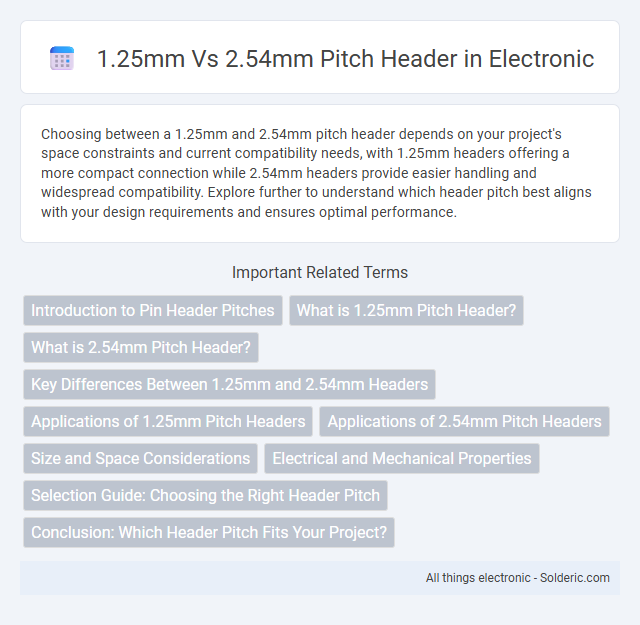Choosing between a 1.25mm and 2.54mm pitch header depends on your project's space constraints and current compatibility needs, with 1.25mm headers offering a more compact connection while 2.54mm headers provide easier handling and widespread compatibility. Explore further to understand which header pitch best aligns with your design requirements and ensures optimal performance.
Comparison Table
| Feature | 1.25mm Pitch Header | 2.54mm Pitch Header |
|---|---|---|
| Pin Pitch | 1.25mm | 2.54mm (0.1 inch) |
| Use Case | Compact electronics, high-density PCBs | Standard through-hole, prototyping boards |
| Current Rating | Typically 1-1.5A per pin | Up to 3A per pin |
| Mechanical Strength | Lower due to smaller size | Higher, suitable for robust connections |
| Compatibility | Less common, specialized connectors | Widely supported, industry standard |
| Application | Mobile devices, wearable electronics | Arduino, Raspberry Pi, general prototyping |
| Cost | Higher per unit due to precision | Lower, mass produced |
Introduction to Pin Header Pitches
Pin headers come in various pitch sizes, with 1.25mm and 2.54mm being among the most common standards in electronics. The 2.54mm pitch is widely used for general prototyping and breadboards due to its compatibility with standard connectors, while the 1.25mm pitch is favored for compact designs requiring higher pin density. Choosing the right pitch impacts the size, compatibility, and application of your electronic projects, making it essential to understand their differences.
What is 1.25mm Pitch Header?
A 1.25mm pitch header refers to a type of electronic connector with a 1.25 millimeter spacing between adjacent pins, commonly used in compact electronic devices due to its small size. This header offers higher pin density compared to the standard 2.54mm pitch header, making it ideal for applications requiring space-saving solutions. Understanding your device's requirements helps determine if a 1.25mm pitch header is suitable for optimizing connectivity and PCB design.
What is 2.54mm Pitch Header?
A 2.54mm pitch header is a type of electrical connector with pins spaced 2.54 millimeters apart, commonly used in electronics for prototyping and connecting circuit boards. This standard pitch allows compatibility with a wide range of breadboards, jumper wires, and headers, making it ideal for hobbyists and professionals alike. Choosing the right header pitch, such as your decision between 1.25mm and 2.54mm, depends on the spatial requirements and electrical specifications of your project.
Key Differences Between 1.25mm and 2.54mm Headers
1.25mm and 2.54mm pitch headers differ primarily in pin spacing, with 1.25mm headers offering a more compact form factor suitable for high-density PCB designs, while 2.54mm headers provide easier handling and compatibility with standard breadboards and connectors. The 1.25mm pitch supports finer pitch connections, enabling reduced board size and improved signal integrity for modern electronics, whereas 2.54mm headers are favored for prototyping and legacy systems due to their robust size and widespread availability. Electrical current ratings and mechanical durability also vary, with 2.54mm headers generally accommodating higher current loads and offering greater mechanical strength compared to the smaller 1.25mm variants.
Applications of 1.25mm Pitch Headers
1.25mm pitch headers are primarily used in compact electronic devices where space savings are crucial, such as smartphones, wearables, and portable medical equipment. Their smaller pitch allows for higher pin density in constrained PCB layouts, making them ideal for internal connections in dense circuit designs. You benefit from improved miniaturization and reliable electrical connections in applications requiring precise, high-density interconnects.
Applications of 2.54mm Pitch Headers
2.54mm pitch headers are widely used in electronics due to their compatibility with breadboards, standard perfboards, and common connectors, making them ideal for prototyping and DIY projects. This pitch size supports robust mechanical and electrical connections in microcontroller boards, development kits, and sensor modules. Your choice of a 2.54mm header ensures seamless integration with a broad range of components and accessories in hobbyist and professional applications.
Size and Space Considerations
The 1.25mm pitch header offers a compact footprint ideal for densely packed PCBs where space optimization is critical, reducing overall device size and enabling slimmer designs. In contrast, the 2.54mm pitch header requires more board space, making it suitable for applications where durability and ease of manual soldering or connector mating are priorities. Choosing between the two depends on balancing space efficiency with mechanical robustness and ease of assembly in the final product.
Electrical and Mechanical Properties
The 1.25mm pitch header offers higher pin density, making it ideal for compact electronic designs with limited PCB space, while the 2.54mm pitch header provides greater mechanical robustness and ease of manual soldering due to its larger size. Electrically, the smaller 1.25mm pitch headers tend to have lower current ratings, typically around 1A per pin, compared to 3A or higher for 2.54mm pitch headers, which affects power handling capabilities. Mechanical durability favors 2.54mm pitch headers as their larger size and increased pin spacing reduce the risk of mechanical stress and contact failure during insertion and removal cycles.
Selection Guide: Choosing the Right Header Pitch
Selecting the right header pitch depends largely on your device's space constraints and connection requirements. A 1.25mm pitch header offers a compact solution ideal for high-density applications and devices with limited PCB real estate, while a 2.54mm pitch header provides easier handling and compatibility with standard breadboards and connectors. Your choice should balance the need for miniaturization against assembly convenience and mechanical strength.
Conclusion: Which Header Pitch Fits Your Project?
Choosing between 1.25mm and 2.54mm pitch headers depends on the project's space constraints and current component compatibility. The 1.25mm pitch is ideal for compact designs requiring high-density connections, commonly found in modern electronics like smartphones and laptops. The 2.54mm pitch header suits prototyping and educational projects due to its robustness, easier handling, and widespread support across standard development boards.
1.25mm vs 2.54mm pitch header Infographic

 solderic.com
solderic.com